Circuit elements
 Our bodies separate and store charge as a power source to transmit signals
along nerves. An excess of positive ions on the outside
of the cell membrane results in a potential difference across the membrane.
The inside of the cell is at a negative potential of ~100 mV with respect to the
outside. The membrane acts like a capacitor.
Our bodies separate and store charge as a power source to transmit signals
along nerves. An excess of positive ions on the outside
of the cell membrane results in a potential difference across the membrane.
The inside of the cell is at a negative potential of ~100 mV with respect to the
outside. The membrane acts like a capacitor.
Electrical signals play a
role in transmitting information through our bodies. Sensory
information is transmitted via nerves. Each nerve consists of a
bundle of nerve cells or neurons. A neuron receives stimuli at the
input end and produces a signal that is transmitted across the axon to
the output end. The axon membrane can be modeled as a charged
capacitor. When the neuron is stimulated, the voltage across the
capacitor rapidly changes and the charge on the plates reverses, only to
thereafter quickly return back to its original value. For this to
happen, a current must flow through some effective resistance. The
whole axon can be modeled as a chain of capacitors and resistors
connected in series and parallel. A voltage and current pulse
propagates along this chain.

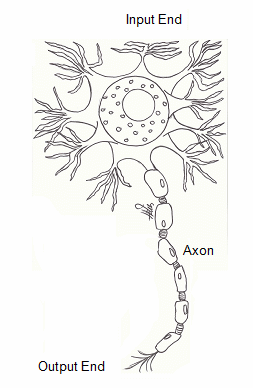 The speed of propagation of the
action potential depends on the electrical resistance R within the core
of the axon and the capacitance C across the membrane. A simple
electrical circuit, consisting of a resistor in series with a capacitor,
has a time constant τ = RC. The
time constant characterizes the time it takes for the capacitor to
charge and discharge and therefore limits the maximum speed with which
signals can travel through the circuit.
The speed of propagation of the
action potential depends on the electrical resistance R within the core
of the axon and the capacitance C across the membrane. A simple
electrical circuit, consisting of a resistor in series with a capacitor,
has a time constant τ = RC. The
time constant characterizes the time it takes for the capacitor to
charge and discharge and therefore limits the maximum speed with which
signals can travel through the circuit.
In this laboratory you will investigate the behavior
of simple circuits containing resistors and capacitors. While you
will not model neurons directly, you will become more familiar
with how circuits in general behave, and therefore also with how neuron circuits behave.
Open a Microsoft Word document to keep a log of your experimental procedures,
results and discussions. This log will become your lab report. Address the
points highlighted in blue. Answer all questions.
The resistance of your body
Fatal electric shock occurs when a sufficiently large electric
current flows through the body. A fraction of such a current flows through the
heart and may disrupt the cardiac cycle. Typical effects are listed in the
table below.
| Shocking current: |
Effect: |
| <1 mA |
no observable effect |
| ~1 mA - ~10 mA |
tingling sensation |
| ~10 mA - ~100 mA |
muscular paralysis
("can't let go") |
| ~100 mA |
ventricular fibrillation |
| ~1A - ~10 A |
thermal damage to tissue |
Paradoxically, brief currents of > 1 A may be less dangerous than lower
currents. Instead of putting the heart into ventricular fibrillation, these currents clamp the whole heart muscle at the same time. When the
current is turned off, a normal heart beat may resume on its own accord.
Indeed, currents of about 1 A are used clinically to defibrillate the heart.
Experiment 1 (optional)
Do you have a digital multimeter? Then use it to measure the resistance of your body.
Switch the meter on the 20 MΩ (or closest) scale.
Make sure the leads are plugged into the Ω and COM
connectors of the meter. Press the thumb of one of your
hands against the black and the thumb of the other hand against the red lead.
Record the measured values with dry and with wet
thumbs.
- Predict the current that would flow through your body if you held
one terminal of a 1.5 V battery in one of your hands and the other terminal in
the other hand.
- Predict the current that would flow through your body if you held one terminal
of a 110 V power source in one of your hands and the other terminal in the other
hand.
The salty fluids within the human body are electrical conductors. Salt
water conducts electricity because it has mobile electrons and ionic states via
the salt atoms. Salt water provides a large surface area of contact for
the conductive element and it connects with the sweat glands so electricity can
flow past the skin and into your body, which has low electrical resistance. The internal resistance of an arm (from hand to shoulder) is less than 100 Ω. If there is a voltage across this internal resistance, a current will flow and
heat will be generated. If the current is large or the connection time is long
enough, this heat will cause burns and destroy tissue. Fortunately the
resistance of dry skin is high. The dry protein of your skin is an
insulator. Using a typical contact area, the skin acts
like an approximately (10 - 100) kΩ resistor in series with the internal
resistance of the body. At voltages below about 50 V the dry skin
provides safe current limiting protection.
If you do not have a digital multimeter, discuss the outcome of this
experiment with other students were able to perform this
experiment in the discussion forum.
Be extremely careful not to have electrical contact with a voltage
source if you have wet or sweaty skin.
DC circuits
Activity 1
Link to the simulation:
https://phet.colorado.edu/en/simulations/circuit-construction-kit-dc
Click the Lab icon. Explore the interface!
- Components are dragged from the toolbox to make circuits.
- To explore the properties of a component, tap it. You can then
change many properties and also remove the component.
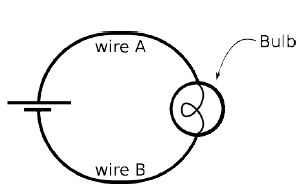 (a) Use one ideal battery (40 V, 0 Ω internal
resistance), a light bulb (30 Ω) resistance) and ideal wires (near 0
Ω resistance) to build the circuit shown on the right. Make sure your
light bulb lights up. Use the voltmeter to measure the potential difference (ΔV)
across the battery. Record only the magnitude of the potential
difference (omit +/- signs). Make a similar potential difference
measurement across the bulb and across each length of wire. With
the noncontact ammeter, measure the current through the bulb, IBulb.
(a) Use one ideal battery (40 V, 0 Ω internal
resistance), a light bulb (30 Ω) resistance) and ideal wires (near 0
Ω resistance) to build the circuit shown on the right. Make sure your
light bulb lights up. Use the voltmeter to measure the potential difference (ΔV)
across the battery. Record only the magnitude of the potential
difference (omit +/- signs). Make a similar potential difference
measurement across the bulb and across each length of wire. With
the noncontact ammeter, measure the current through the bulb, IBulb.
What to do if you have problems with the
animation speed!
Fill in "Table A" below..
| ΔVBattery |
ΔVwire A |
ΔVwire B |
ΔVBulb |
IBulb |
| |
|
|
|
|
Now use two ideal batteries (30 V, 0 Ω internal resistance), three light bulb
(30 Ω) resistance) and as many ideal wires as needed to build several different
circuits.
(b) Use all the components (two 3 batteries, 3 light bulbs) and connect them
in such a way as to they produce the most light. (The largest possible current should
flow through the bulbs. You can connect the batteries and bulbs in series
or in parallel as needed.)
Make measurements and fill in "Table B" below.
Paste a screenshot of your circuit into your word document.
| ΔVBattery |
IBattery |
ΔVany Bulb |
Iany Bulb |
| |
|
|
|
(c) Use all the components (two batteries, 3 light bulbs) and connect them
in such a way as to they produce the least amount of light or current, but not zero light or
current. (The smallest possible non-zero current should flow through the
bulbs.)
Make measurements and fill "Table C" below. Paste a
screenshot of your circuit into your word document.
| ΔVBattery |
IBattery |
ΔVany Bulb |
Iany Bulb |
| |
|
|
|
(d) Set up the circuit shown below with three
30 Ω bulbs and one 30 V battery.
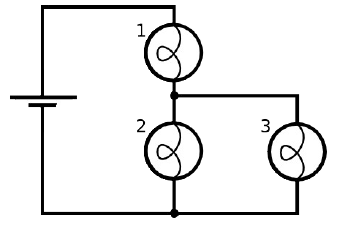
Observe the brightness of the bulbs.
Make measurements and fill in "Table D" below.
| ΔVBattery |
IBattery |
ΔVBulb 1 |
IBulb 1 |
ΔVBulb 2 |
IBulb 2 |
ΔVBulb 3 |
IBulb 3 |
| |
|
|
|
|
|
|
|
(e) Change the internal resistance of the battery to 2 Ω. What
happens?
Make measurements and fill in "Table E" below.
| ΔVBattery |
IBattery |
ΔVBulb 1 |
IBulb 1 |
ΔVBulb 2 |
IBulb 2 |
ΔVBulb 3 |
IBulb 3 |
| |
|
|
|
|
|
|
|
Paste Tables A - E into your log and comment on your measurements.
Ohmic and non-ohmic circuit elements
Activity 2
- Watch
this Youtube video clip discussing resistors.
As far as a circuit is concerned, any device that converts
electrical energy into thermal energy is a resistor. But most devices have
a more descriptive name, such as hair dryer or heating element, etc.
There are devices that are referred to as resistors, primary purpose is the
limit the current flowing in a circuit.
- Watch this
Youtube
video clip discussing the resistance of a light bulb.
If a 9 V battery causes the same current to flow through a resistor and a
light bulb, both devices dissipate the same power. But the temperature
of the resistor barely changes, while the light bulb gets very hot.
The resistor has a large surface area and dissipate heat efficiently by
conduction and convection in air. The light bulb filament has a small
surface area and is in near vacuum. It mainly dissipates heat by
radiation. That only becomes efficient at high temperature, because
the radiated power is proportional to thr temperature to th 4th power. (Stefan-Boltzmann
Law).
- Watch this
Youtube
video clip discussing diodes and LEDs.
Diodes and LEDs ar semiconductor devices with conduction characteristics that
can be understood using quantum mechanics but not classical theory.
In a few sentences explain how you can perform and experiment to find out if
a circuit element is ohmic or nonohmic. What measurements do you make and
how do you decide, based on the results of your measurements.
RC circuits
Activity 3
Link to the simulation:
https://phet.colorado.edu/en/simulations/circuit-construction-kit-ac
Click the Lab icon. Construct a circuit as shown in the diagram below.
Choose R = 50 Ω, C = 0.2 F, V = 9 V.
Use the voltmeter to measure the voltage across the capacitor.
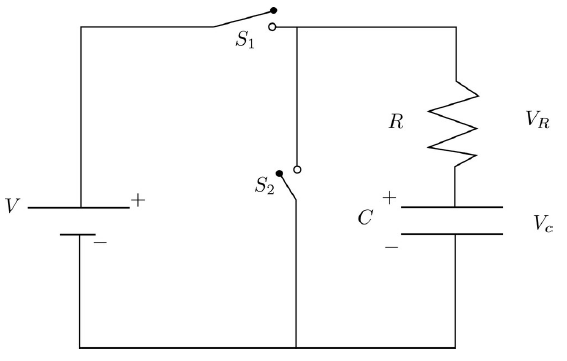
An example is shown below.
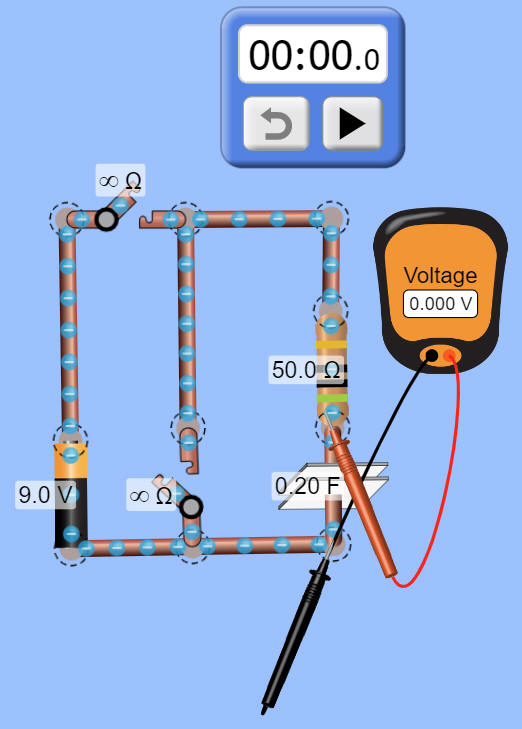
Charging the capacitor:
With the simulation paused, start by clicking on the capacitor to discharge
it. The initial voltage across the capacitor should be 0 V.
Click the start button on the stopwatch. The stopwatch will start when you
play the simulation. Close switch S1.
You will monitor the voltage across the capacitor as a function of time as
the capacitor in the
RC circuit is
charging. Start the simulation, then pause it at roughly 0.5 V
intervals between 1 V and 8.9 V and record the voltage and time in a table in
this
spreadsheet.
- Paste a screenshot of your circuit into your word document.
- Construct a plot of Vc versus t and paste it into your word
document. (Make sure you do not switch the axes.)
We expect VC = V0(1 - e-t/τ), where V0
= 9 V is the battery voltage. We
can rewrite this as 1 - VC/V0 = e-t/τ,
or ln(1 - VC/V0) = -t/τ.
If we plot ln(1 - VC/V0) versus time the slope will be -1/τ,
where τ is the time constant of the RC circuit.
- Add a ln(1 - VC/V0) column to your
spreadsheet. (The first row with the formula is already filled in.)
- Plot ln(1 - VC/VO) versus time.
- Add a linear trendline, with the intercept set to zero and display the
equation on the chart.
- Paste it into your word document.
- What is your measured time constant of the RC circuit?
- How does this compare to the expected time constant τ = RC?
- How long does it take to charge the capacitor to VC = 4.5 V?
Discharging the capacitor:
When the capacitor is fully charged and the voltage across the capacitor is
9V, pause the simulation.
Reset and start the stopwatch.
Open switch S1 and close switch S2.
Monitor the voltage across the capacitor as a function of time as
the capacitor in the
RC circuit is
discharging. Start the simulation, then pause it at roughly 0.5 V intervals
between 8 V and 0.1 V and record the voltage and time in the spreadsheet.
- Construct a plot of Vc versus t and paste it into your word
document. (Make sure you do not switch the axes.)
- How long does it take to discharge the capacitor to VC = 4.5 V?
Convert your log into a lab report.
See the grading scheme for all lab
reports.
Name:
E-mail address:
Laboratory 3 Report
- In one or two sentences, state the goal of this lab.
- Make sure you completed the entire lab and answered all parts. Make
sure you show your work and inserted and properly labeled relevant tables
and plots.
- Add a reflection at the end of your report in a short essay format.
Save your Word document (your name_lab3.docx), go to Canvas, Assignments, Lab
3, and submit your document.
 Our bodies separate and store charge as a power source to transmit signals
along nerves. An excess of positive ions on the outside
of the cell membrane results in a potential difference across the membrane.
The inside of the cell is at a negative potential of ~100 mV with respect to the
outside. The membrane acts like a capacitor.
Our bodies separate and store charge as a power source to transmit signals
along nerves. An excess of positive ions on the outside
of the cell membrane results in a potential difference across the membrane.
The inside of the cell is at a negative potential of ~100 mV with respect to the
outside. The membrane acts like a capacitor.
 The speed of propagation of the
action potential depends on the electrical resistance R within the core
of the axon and the capacitance C across the membrane. A simple
electrical circuit, consisting of a resistor in series with a capacitor,
has a time constant τ = RC. The
time constant characterizes the time it takes for the capacitor to
charge and discharge and therefore limits the maximum speed with which
signals can travel through the circuit.
The speed of propagation of the
action potential depends on the electrical resistance R within the core
of the axon and the capacitance C across the membrane. A simple
electrical circuit, consisting of a resistor in series with a capacitor,
has a time constant τ = RC. The
time constant characterizes the time it takes for the capacitor to
charge and discharge and therefore limits the maximum speed with which
signals can travel through the circuit. (a) Use one ideal battery (40 V, 0 Ω internal
resistance), a light bulb (30 Ω) resistance) and ideal wires (near 0
Ω resistance) to build the circuit shown on the right. Make sure your
light bulb lights up. Use the voltmeter to measure the potential difference (ΔV)
across the battery. Record only the magnitude of the potential
difference (omit +/- signs). Make a similar potential difference
measurement across the bulb and across each length of wire. With
the noncontact ammeter, measure the current through the bulb, IBulb.
(a) Use one ideal battery (40 V, 0 Ω internal
resistance), a light bulb (30 Ω) resistance) and ideal wires (near 0
Ω resistance) to build the circuit shown on the right. Make sure your
light bulb lights up. Use the voltmeter to measure the potential difference (ΔV)
across the battery. Record only the magnitude of the potential
difference (omit +/- signs). Make a similar potential difference
measurement across the bulb and across each length of wire. With
the noncontact ammeter, measure the current through the bulb, IBulb.

